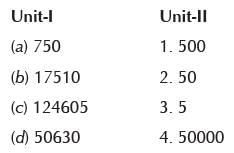Olympiad Test: Number Sense - Class 5 MCQ
20 Questions MCQ Test Math Olympiad for Class 5 - Olympiad Test: Number Sense
What is the predecessor of the greatest six-digit number?
What is difference between the place values of two 5’s in the number 4598351?
| 1 Crore+ students have signed up on EduRev. Have you? Download the App |

Which of the following signs can be placed in the box between the two numbers?

How many three-digit numbers can be formed with the digits 3, 0 and 7 without repetition?
Which are the respective greatest and the smallest numbers amongst 321987, 319240, 321978 and 321970?
What is the difference between the greatest and smallest 5-digit numbers formed by using all the digits 3, 0, 9, 1 and 5?
How can the number fifty million twenty-one thousand two hundred thirty six be written using commas according to Indian system of numeration?
How can the numbers 10 million, 1 billion and 216 thousand be arranged in descending order?
The number 24 is to be written as a product of its prime factors. Which one of the following is correct?
The number 90 is to be written as a product of its prime factors. Which one of the following is correct?
Match the following numbers in list I with the corresponding place value of number 5.


|
32 videos|57 docs|45 tests
|
|
32 videos|57 docs|45 tests
|




 2,357,799
2,357,799















